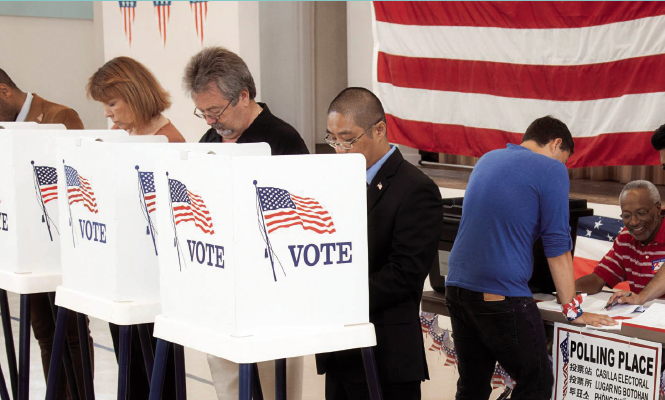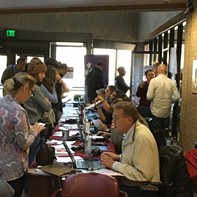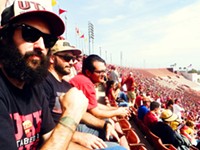Page 2 of 4
Lyle Hillyard, Utah's senior-most state senator from Cache County, probably wasn't sweating too much when he won his seat back in 1984 with 62 percent of the vote over Democrat Omar Bunnell.
Seven elections and 32 years later, Hillyard still doesn't have much to fret about. His run for the state's 25th Senate District in 2012 went uncontested, as are his efforts this year. In 2008, he won with 73 percent of the vote; in 2004, 77 percent, etc., etc.
When voters go to the polls on Nov. 8, Hillyard certainly won't be the only legislative candidate who failed to garner an opponent: 27 other legislators are going unchallenged—a full quarter of the state's most high-profile lawmaking body.
The frictionless path that many Utah lawmakers travel on their way to public office can be traced, in part, to the state's polarized voting base, which nearly everywhere except in Salt Lake City, is awash with Republican voters. Another element is Utah's convention system, by which Republican and Democratic candidates alike are picked to appear on general election ballots by delegates, rather than by voters in an open primary.
These uncontested races, of course, do not take into account the many lawmakers who will most likely win their seats in a landslide, as Hillyard does whenever anyone dares to take him on.
This lack of contention, says Mark Thomas, the state's director of elections, has a tendency to stifle voter turnout and, potentially, fuel voter apathy.
"I think generally, it is an interesting dynamic that Utah faces with a high number of uncontested races that we have," Thomas says. "That has an effect on the way voters look at elections. I think that that draws into the voter apathy that we hear oftentimes from voters, and from candidates as well."
In an effort to spur more political competition and encourage voter participation, the Count My Vote initiative from 2014 aimed to torpedo the state's convention system and create the sort of open primaries favored by most states.
Fearful that voters would indeed turn out to end the convention system if the initiative made it onto the ballot, lawmakers struck a compromise with Count My Vote organizers. The convention system would be preserved, but candidates wishing to circumvent appealing to party delegates could instead gather signatures and force a primary election.
Taylor Morgan, executive director of Count My Vote, says that the creation of a signature-gathering path to the ballot was an important step in making elections more vital and competitive in Utah. But with the convention system intact, he says most voters remain frozen out of the process that often ends up being the most important: picking a candidate to appear on the ballot.
By avoiding direct primaries and appealing to a relatively small number of delegates, a candidate like Hillyard, who did not draw a competitor during the Republican Party's convention, and also failed to provoke a Democrat to run against him, was effectively elected by the delegates in April. His name, and the names of several of his colleagues who slid through the process in similar fashion, will appear on the general election ballot only as a formality. The outcome has already been decided, and whether one person or 10,000 people cast ballots for Hillyard, he will receive 100 percent of the votes.
"A lot of times in Utah, the most pivotal decisions are made in the party nomination process," Morgan says. "Just a very tiny number of party delegates in both parties are making that decision on behalf of hundreds of thousands of voters."
While this system has been lampooned by voting-rights activists and Count My Vote organizers, it has been staunchly defended by the Utah Republican Party, which has sued, but seen its legal endeavors wither, in an attempt to undo the compromise that allowed signature-gathering.
Phill Wright, co-chairman of the Utah GOP, says that the convention system is the single best way to vet candidates before they traipse out before the public. He says it's important for the party to maintain this level of control in order to ensure that candidates claiming to represent Republicans truly do have Republican values.
And far from stifling participation, Wright believes that the convention system allows more Utahns to become involved with the political process by participating in neighborhood caucuses and helping to select the party's delegates.
When it comes to Utah's lowly voter-turnout rates, which are perennially among the lowest in the country, Wright says he believes this speaks more to the fact that the state's politicians are doing a fine job than it does to voter apathy.
"I think what leads to low voter turnout in any state, or any city for that matter, is when residents feel like things are OK," Wright says. "If people feel like things are functioning properly, they don't get involved."
Morgan of Count My Vote says that when he cast his first ballot as a voter in Utah County, the fact that almost all of the seats up for grabs had only a single name running did not make him feel as though everything was great, just that voting was pointless.
But the convention system isn't entirely to blame, Morgan says. The simple fact that Utah boasts 713,248 registered Republicans to 172,542 registered Democrats, means that challenges from minority party candidates in many pockets of the state are frivolous endeavors.
And if politics is little more than a big game of numbers, it seems unlikely that competitive races could unfold in many counties, including in Cache County, where the majority of Hillyard's voting base lives. In this county, there are 4,225 Democrats, or roughly 7.7 percent, compared to 34,270 Republicans, which makes up 55.8 percent of the voting base. The numbers are similar in Utah County, where 15,500 registered Democrats reside, compared to 159,897 Republicans.
"If I were professionally advising a candidate there, I would say, 'You don't have a path to win this election because elections come down to numbers,'" Morgan says. "The unfortunate reality is that right now we have a two-party system. The math simply doesn't add up to provide a pathway to win the election."
Another hurdle exists for candidates hoping to take on perennial favorites like Hillyard: straight-ticket voting. No matter how enticing a candidate might be with a "D" next to his or her name, the simple fact that it's not an "R" is a massive hurdle.
During the 2014 general election, 193,828 Utah voters simply checked the single-party voting option on the top of their ballots. The vast majority of these, 122,298, were cast by Republicans. This number accounted for a full 63.1 percent of all Republican ballots cast in the state.
While Wright says the Republican Party will continue to defend its right to vet candidates and fight efforts to circumvent the convention process, he says that Utah's system of close vetting before the public gets its say could have been useful during this year's presidential race, which saw the businessman Donald Trump crowned the party's nominee.
By letting people choose, rather than passionate Republican delegates, Wright says, "That's why we have someone like Donald Trump as our nominee."
More by Colby Frazier
-
Fire Line
UFA Board considers recouping bonuses paid to former chiefs and turning investigation over to law enforcement.
- Jan 25, 2017
-
Home Sweet Home?
How a single real estate deal highlights a city in flux and in crisis.
- Jan 4, 2017
-
Dead Red
That Utah could end up voting something other than Republican proved delusional.
- Nov 9, 2016
- More »
More by Dylan Woolf Harris
-
Dabakis Is Leaving the Building
Ever boisterous and outspoken, state senator says lending liberal voice trumps his bill tally.
- Apr 4, 2018
-
Gagged and Bound
Row between South Salt Lake and muralist gets the burlesque treatment.
- Mar 21, 2018
-
Inland Port Authority Update
Gov. Herbert signs contested bill into law.
- Mar 16, 2018
- More »
Latest in Cover Story
Readers also liked…
-
Forget the family pedigree—Robert F. Kennedy Jr should not be the next president of the United States
Trojan Horse
- Jun 21, 2023
-
Women decry harassment and toxic culture at St. George auto dealership
Men at Work
- Oct 11, 2023










